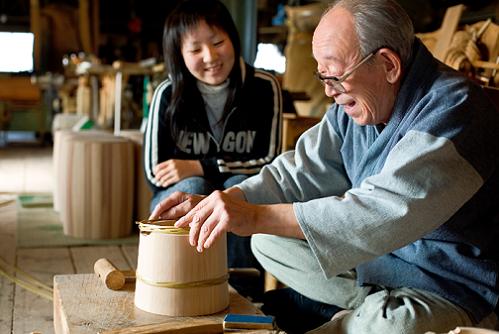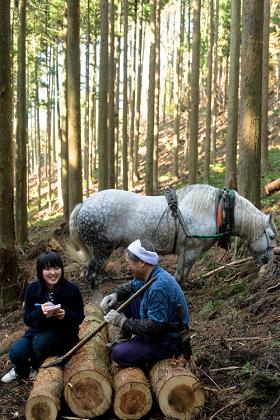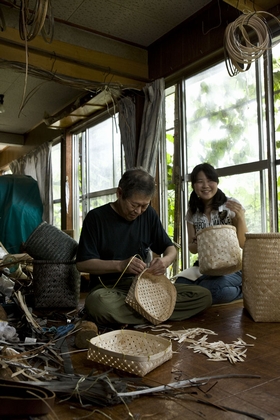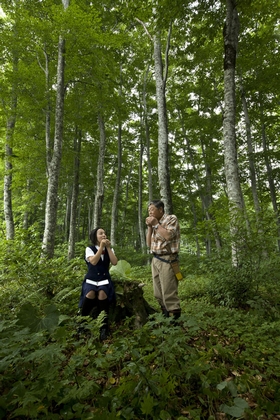September 17, 2009
Development of the 'Foxfire in Japan' Program for High School Students to Learn from Forest Masters
Keywords: Newsletter
JFS Newsletter No.84 (August 2009)

Copyright Takafumi Okuda
The "Foxfire in Japan" program was launched in 2002, and is unique in that it involves 100 high school students selected annually nationwide who are asked to write essays about what they learn from interviewing "forest masters" about their wisdom, skills, ideas and way of living. Forest masters are people who are accomplished in skills learned from elder experts in forest-related work such as logging, tree planting, charcoal making, boat building, comb making, plant dyeing, and bee-keeping. They also include manufacturers of masks used for Shinto dances, shrine rope makers and growers of Japanese shiitake mushrooms.
The Foxfire in Japan program connects "forests" with "high school students," two things not normally lumped together. How are they related? What is created through the program? In fact, high school students' efforts under this program have evoked sympathy throughout the country and created a new initiative. We introduce the program's development based on its website and an interview of one of its initiators.
In the past, Japan's traditional lifestyle and culture were pursued in the process of protecting, growing, and harnessing forests. However, as a result of the promotion of industrialization and urbanization, most modern Japanese no longer have any relationship with forests in their daily lives. To help protect, grow and bequeath to the next generation forests that can play an important role in Japan and the global environment, the Foxfire in Japan program offers an opportunity to think about the future by focusing on forest-related wisdom and skills. It is managed by a committee comprised of four parties: Japan's Forestry Agency; the Ministry of Education, Culture, Sports, Science and Technology; the National Land Afforestation Promotion Organization; and a non-profit organization, the Trees and Environment Network Association.

Copyright Takafumi Okuda
In the essay-writing program, each student interviews a forest master about his or her wisdom, skills, and way of life. Then the student compiles what he or she has learned using only the masters' words. Through this process, the students get a feeling for how people get along with forests and how the masters live. The essays the students write are not only accumulations of words about the masters' skills and spirit, but also function as evidence of communication across the generations.
How do the students record what they hear and learn through their interviews? In the beginning of August, 100 students are selected as representatives of their districts. They get together from across the country, participate in a workshop on interviews and writing, receive practical training and are introduced to forest masters' wisdom and skills.
After going through the training program, the students plan their interviews and essays. Each looks at forest master skills, thinks about questions to ask, checks out the transportation available to visit the master, and contacts the master to schedule the visit.

Copyright Takafumi Okuda
From fall to winter, students visit the masters for interviews. During the interviews, they record what the masters say, take pictures of the masters working, and even participate in the actual work. After going home, the students transcribe the recorded tape.
In winter, they compile the transcript as a completed essay, considering its points, structure, and photo layout.
Finally, a forum is held in spring as a venue for presenting their work. Some student representatives and masters are chosen to make a live presentation at the forum. All the essays written by the 100 students are published in a booklet and released on the Internet.
So far, a total of 700 high school students have participated in the "Foxfire in Japan" essay-writing program and 700 essays have been written in the seven years since 2002.
Here are some quotes from forest masters.
- "I am 68 years old, but I still think of myself as a novice in my job. My training will continue as long as I live." (master of boat building in Ishikawa Prefecture)
- "Communicating with trees is the most essential skill in our job." (master of tree planting in Kagawa Prefecture)
- "We have to take good care of forests so that our offspring can make use of them." (master of tree planting in Tokyo)
- "Wood from forests should be properly recycled. Only we, human beings, can do it." (master of charcoal making in Wakayama Prefecture)
- "Many people tend to be money-conscious, calculating profits and losses. They are quite far from living a fulfilling life, aren't they?" (master of tree planting in Ishikawa Prefecture)
So, how did student participants feel after their interactions with masters? Let's introduce some reactions from the young people.
- "This might be a kind of life-changing experience for me."
- "I think it's important to pass down masters' stories to others."
- "I'm glad to have had a chance to think about ways of living with forests."
- "Through writing essays of our interviews with forest masters, we can learn about their lives."
- "There is no pretense in the skills and words of masters. I was really happy to be able to meet them."
- "I was impressed to meet a master who is looking 100 years ahead. I want to pass down the essential things in our predecessors' wisdom to the next generation."

Copyright Takafumi Okuda
Some of the students who participated in the Foxfire in Japan program created groups to voluntarily support new participants in their training, and to start a campaign for the coexistence of people and forests. This latter campaign is regionally based and aims to create active connections between local people and nature in order to promote regional revitalization together with woodland and forest cultivation.
Also, a new project for recording forest masters' way of talking, facial expressions and skills on video has started, because such things are difficult to communicate through text-based documents.
With support from forest masters and other people, a non-profit organization, the Network for Coexistence of Local People and Forests, was established in December 2007. Former participants of the Foxfire in Japan program plan and operate most of its activities aimed at expanding its network.
Young People Start a Campaign Promoting the Coexistence of People and Forests
http://www.japanfs.org/en/pages/028671.html
Finally, we would like to introduce a story told by Juichi Shibusawa about his commitment and passion for forests from an interview posted on the "watashinomori (my forest).jp" website, a communication platform for connecting people's thoughts and their daily lives with forests. He is the vice chairman of the abovementioned Network and one of the initiators of the Foxfire in Japan program.
--------------------------
"An encounter with a forest became a turning point in my life 15 years ago. Someone told me, 'Why don't you visit Uyashinai? It's a place like paradise because no one has died from starvation there since the Edo Period (1603-1867), despite the great Edo period famines (the Tenmei famine in the 1780s and the Tenpo famine of 1830).' I was thus invited to visit the small village of Uyashinai, Kawabe Town (now Akita City) in Akita Prefecture. Uyashinai is a very isolated village deep in the mountains, located upstream of a tributary of the Iwami River in the Omono River system. It was curious that none of the villagers had starved to death even during these great famines.
"I wondered why, and I rented a house with friends for 1,000 yen (US$10.3) per month in Uyashinai. The village had about 33 woodlands of Quercus crispula or Japanese oak shared by the villagers, and the villagers cut down one forest at a time every year. I asked them one day, 'Doesn't it increase the risk of a landslide when you cut down the trees on a steep mountainside?' They laughed at me, saying 'you don't understand anything at all'.
"According to the villagers, most of the mountains I had seen so far in my life were plantations of cedar and cypress. When such trees are cut down, their roots also die and rot away in about ten years. Heavy rain will cause landslides on mountain slopes planted with these commercial forests. On the contrary, the roots of hardwood trees like Japanese oak survive after the trees are cut down, and the trees grow again from the stumps, developing branches and leaves. After the 33 year cycle, the trees in the areas cut down 34 years ago will have grown large again. This is how these villagers utilize their local forests sustainably.
"Moreover, after two years, bracken starts to grow at a clear-cut, and in three years it grows into thick, wild brush. Bracken shoots can be pickled in salt as a preserved food. After seven years, the remaining stumps start to erode, and mushrooms start to grow there, providing a precious food resource. Villagers can walk to the forest, gather firewood and pack it out in two hours. Fodder for cattle and horses and fertilizer for rice fields are also forest products. Putting it simply, no one had ever starved to death because 'the forests fed the villagers.'
"This is how people used to wisely utilize forest resources. They could sustain their lives thanks to natural blessings produced as part of the natural increment of the forests. As a consequence of getting along with the forests and using their resources to make their daily lives easier, people in the past established a sustainable forest system that helped conserve forest biodiversity. With no knowledge of carbon dioxide emissions, people were instinctively aware that it would be impossible to support their living without balancing the natural speed of forest growth with their use of forest resources. They knew they could not harvest forest products faster than the forests could replenish them or procrastinate about cutting trees and underbrush.
"Before I encountered this idea, nature was for me an object for scientific observation and agricultural use. I believed that 'I live on this side, and the forest exists on the other side', drawing a line between nature and myself. However, I realized from my encounters at Uyashinai that forests and humans depend on each other to survive -- forests cannot sustain themselves without thinning by the villagers because cutting down trees opens space for sunlight that allows other plants to grow, and vice versa. In short, the human being as a species is a part of the ecosystem.
"Uyashinai has an annual festival in which they invite a god of the mountain to visit them. Villagers boil water from a mountain spring and inhale the vapor to unite with the spirit of the mountain god. I felt 'I'm a part of the forests here, this is the way we can live with the forests.' At that moment, I wanted to pray, because prayer is inherently an act of uniting with nature."
--------------------------
The "Foxfire in Japan" program provides opportunities for high school students to consider interconnecting or co-existing with forests, and the true meaning of living in forests through hands-on experiences, discovery and insights. This initiative also provides precious experiences, feelings and ideas to the adults who watch over, encourage and support them.
Written by Junko Edahiro
See also:
High School Students Learn from Forest 'Masters' through Interviews and Essays
http://www.japanfs.org/en/pages/026350.html
New Website Connects People with Forests
http://www.japanfs.org/en/mailmagazine/newsletter/pages/028572.html
Related
"JFS Newsletter"
- 'Good Companies in Japan' (Article No.4): 'Eightfold Satisfaction' Management for Everyone's Happiness
- "Nai-Mono-Wa-Nai": Ama Town's Concept of Sufficiency and Message to the World
- 'Yumekaze' Wind Turbine Project Connects Metro Consumers and Regional Producers: Seikatsu Club Consumers' Co-operative
- Shaping Japan's Energy toward 2050 Participating in the Round Table for Studying Energy Situations
- 'Good Companies in Japan' (Article No.3): Seeking Ways to Develop Societal Contribution along with Core Businesses


